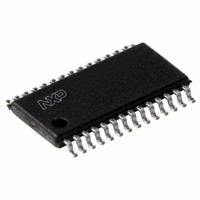P89LPC936FDH,518 NXP Semiconductors, P89LPC936FDH,518 Datasheet - Page 33

P89LPC936FDH,518
Manufacturer Part Number
P89LPC936FDH,518
Description
IC 80C51 MCU FLASH 16K 28TSSOP
Manufacturer
NXP Semiconductors
Series
LPC900r
Datasheet
1.P89LPC936FDH518.pdf
(77 pages)
Specifications of P89LPC936FDH,518
Program Memory Type
FLASH
Program Memory Size
16KB (16K x 8)
Package / Case
28-TSSOP
Core Processor
8051
Core Size
8-Bit
Speed
18MHz
Connectivity
I²C, SPI, UART/USART
Peripherals
Brown-out Detect/Reset, LED, POR, PWM, WDT
Number Of I /o
26
Eeprom Size
512 x 8
Ram Size
768 x 8
Voltage - Supply (vcc/vdd)
2.4 V ~ 3.6 V
Data Converters
A/D 8x8b; D/A 2x8b
Oscillator Type
Internal
Operating Temperature
-40°C ~ 85°C
Processor Series
P89LPC9x
Core
80C51
Data Bus Width
8 bit
Data Ram Size
768 B
Interface Type
I2C/SPI/UART
Maximum Clock Frequency
18 MHz
Number Of Programmable I/os
26
Number Of Timers
2
Operating Supply Voltage
21 V
Maximum Operating Temperature
+ 85 C
Mounting Style
SMD/SMT
3rd Party Development Tools
PK51, CA51, A51, ULINK2
Minimum Operating Temperature
- 40 C
On-chip Adc
8-ch x 8-bit
On-chip Dac
2-ch x 8-bit
Lead Free Status / RoHS Status
Lead free / RoHS Compliant
For Use With
622-1014 - BOARD FOR LPC9XX TSSOP622-1008 - BOARD FOR LPC9103 10-HVSON622-1006 - SOCKET ADAPTER BOARDMCB900K - BOARD PROTOTYPE NXP 89LPC9EPM900K - EMULATOR/PROGRAMMER NXP P89LPC9568-4000 - DEMO BOARD SPI/I2C TO DUAL UART568-3510 - DEMO BOARD SPI/I2C TO UART622-1002 - USB IN-CIRCUIT PROG LPC9XX568-1759 - EMULATOR DEBUGGER/PROGRMMR LPC9X568-1758 - BOARD EVAL FOR LPC93X MCU FAMILY
Lead Free Status / Rohs Status
Lead free / RoHS Compliant
Other names
568-4339-2
935277841518
P89LPC936FDH-T
P89LPC936FDH-T
935277841518
P89LPC936FDH-T
P89LPC936FDH-T
NXP Semiconductors
P89LPC933_934_935_936
Product data sheet
8.15.3 Total Power-down mode
8.16.1 Reset vector
8.16 Reset
This is the same as Power-down mode except that the brownout detection circuitry and
the voltage comparators are also disabled to conserve additional power. The internal RC
oscillator is disabled unless both the RC oscillator has been selected as the system clock
and the RTC is enabled. If the internal RC oscillator is used to clock the RTC during
power-down, there will be high power consumption. Please use an external low frequency
clock to achieve low power with the RTC running during power-down.
The P1.5/RST pin can function as either a LOW-active reset input or as a digital input,
P1.5. The Reset Pin Enable (RPE) bit in UCFG1, when set to logic 1, enables the external
reset input function on P1.5. When cleared, P1.5 may be used as an input pin.
Remark: During a power-up sequence, the RPE selection is overridden and this pin will
always functions as a reset input. An external circuit connected to this pin should not
hold this pin LOW during a power-on sequence as this will keep the device in reset.
After power-up this input will function either as an external reset input or as a digital input
as defined by the RPE bit. Only a power-up reset will temporarily override the selection
defined by RPE bit. Other sources of reset will not override the RPE bit. When this pin
functions as a reset input, an internal pull-up resistance is connected (see
characteristics”).
Reset can be triggered from the following sources:
For every reset source, there is a flag in the reset register, RSTSRC. The user can read
this register to determine the most recent reset source. These flag bits can be cleared in
software by writing a logic 0 to the corresponding bit. More than one flag bit may be set:
Following reset, the P89LPC933/934/935/936 will fetch instructions from either address
0000H or the boot address. The boot address is formed by using the boot vector as the
high byte of the address and the low byte of the address = 00H.
The boot address will be used if a UART break reset occurs, or the non-volatile boot
status bit (BOOTSTAT.0) = 1, or the device is forced into ISP mode during power-on (see
P89LPC933/934/935/936 User manual). Otherwise, instructions will be fetched from
address 0000H.
•
•
•
•
•
•
•
•
External reset pin (during power-up or if user configured via UCFG1).
Power-on detect.
Brownout detect.
Watchdog timer.
Software reset.
UART break character detect reset.
During a power-on reset, both POF and BOF are set but the other flag bits are
cleared.
For any other reset, previously set flag bits that have not been cleared will remain set.
All information provided in this document is subject to legal disclaimers.
Rev. 8 — 12 January 2011
8-bit microcontroller with accelerated two-clock 80C51 core
P89LPC933/934/935/936
© NXP B.V. 2011. All rights reserved.
Table 11 “Static
33 of 77















